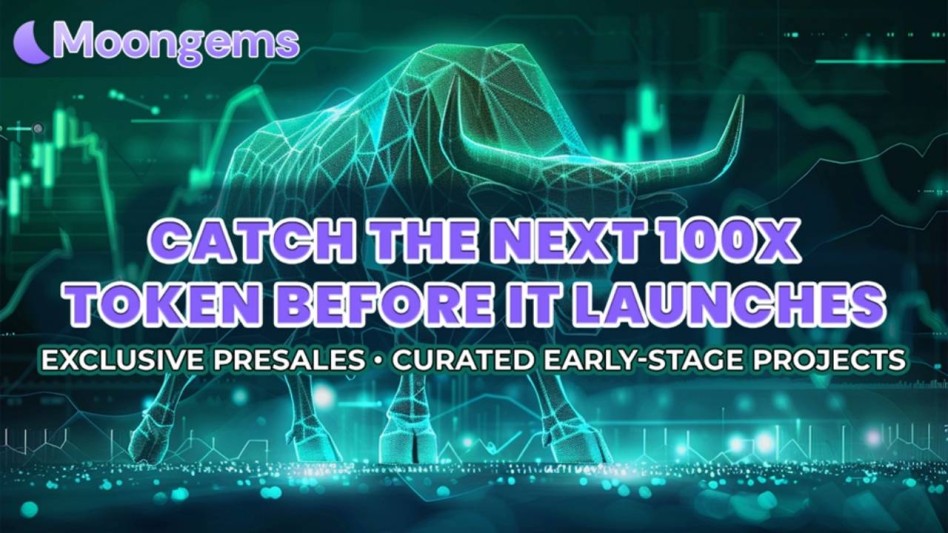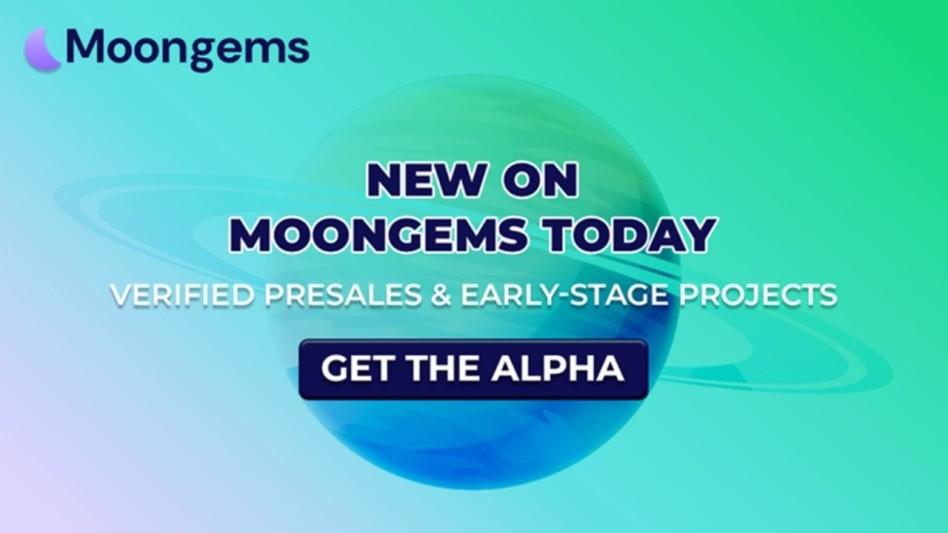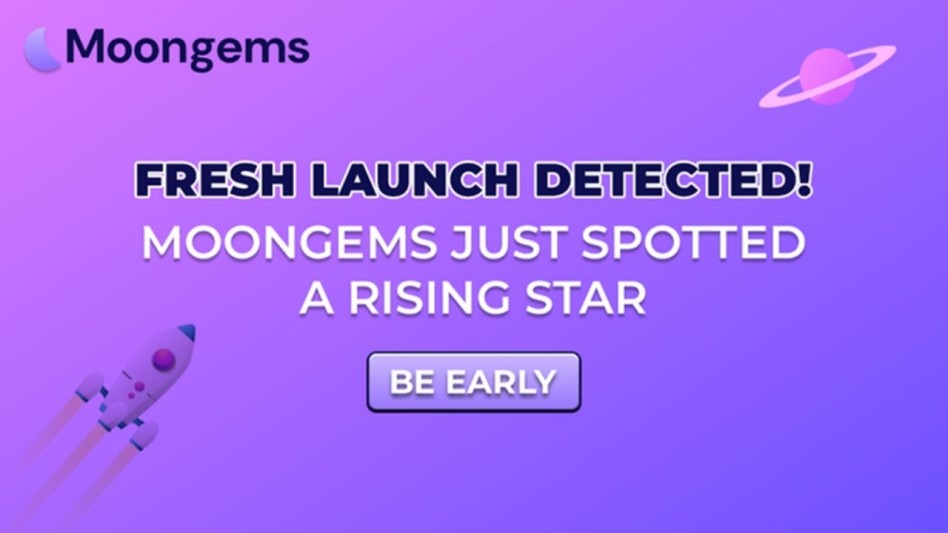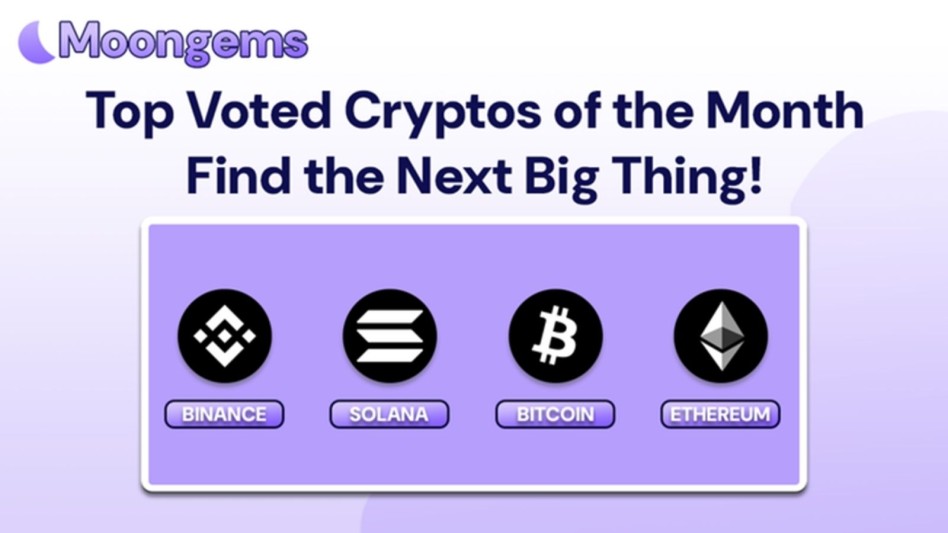Author: Jawad Hussain – Crypto Analyst & Web3 Researcher | 9+ years tracking presales, IDOs, and token launches. Follow him on X (formerly known as Twitter) and LinkedIn.
The crypto presale world in 2025 is a high-stakes arena where fortunes are made, or lost, based on the precision of a single decision: when to exit. For some, perfect timing means doubling or tripling their capital and cashing in for early retirement. For others, a poorly timed exit turns their investment into “exit liquidity” for whales and early movers who have already profited. In an industry known for dramatic swings, finding that sweet spot is more science than luck.
Over the past few years, presale investing has evolved far beyond guesswork. We now have on-chain analytics, sentiment trackers, whale monitoring tools, and AI-driven market signals. Platforms like MoonGems have made these capabilities accessible to retail investors, leveling the playing field against deep-pocketed players who once had an informational monopoly. Yet even with these tools, the challenge remains: when is the right time to step away from a token without leaving too much profit or potential on the table?
Presale exits are not just about spotting the peak price. They involve reading multiple signals: liquidity flows, market sentiment, token unlock schedules, and whale behavior, to decide whether the next big move will take your portfolio higher or lower. Leave too early, and you watch helplessly as the token doubles again. Stay too long, and you might be left holding a rapidly depreciating asset that never recovers.
This article dives deep into the mechanics of presale exit timing in volatile markets. We’ll explore how seasoned investors blend data-driven analysis with market psychology to optimize their returns. We’ll examine real-world case studies of both spectacular successes and painful failures, showing how similar setups can lead to vastly different outcomes. Most importantly, we’ll provide you with actionable strategies, backed by MoonGems insights, to help you avoid becoming someone else’s exit liquidity.
Whether you’re a first-time presale investor or a seasoned trader looking to refine your exit game, this guide will give you the framework, tools, and mindset to make smarter, more profitable decisions in an unpredictable market.
Understanding Exit Liquidity vs. Profit Maximization
In the world of crypto presales, the line between cashing out for life-changing profits and becoming someone else’s exit liquidity is razor-thin. Understanding these two outcomes, and what drives them, is the first step toward mastering presale exit timing.
What Is Exit Liquidity?
In simple terms, exit liquidity refers to investors who unintentionally buy or hold tokens at inflated prices, providing the liquidity that allows early movers and whales to sell their holdings at a profit. Once these large sell-offs occur, the token’s price often crashes, leaving latecomers with steep losses.
In presales, exit liquidity scenarios typically unfold in three ways:
- Post-Launch Pump and Dump: A surge in buying activity right after the token launches, followed by a sharp sell-off from early investors.
- Token Unlock Events: Large allocations for team, private sale investors, or staking rewards are unlocked, flooding the market with supply.
- Narrative Collapse: The hype driving the token’s value fades, often after key promises or milestones fail to materialize.
By tracking wallet activity, liquidity flows, and market sentiment, platforms like MoonGems can often identify the early signs of these events, giving investors a chance to exit before the crowd.
What Is Profit Maximization?
Profit maximization is the opposite scenario: selling at or near the token’s short-term or cyclical peak. It involves exiting while market demand is still strong, liquidity is deep, and the selling pressure from other investors has yet to intensify.
Experienced investors rarely aim for the absolute top. Instead, they focus on capturing the optimal segment of the profit curve, where the risk of a sharp reversal is low and the likelihood of continued gains is modest.
Strategies for profit maximization often include:
- Scaling Out: Selling in increments as the token’s price rises to lock in profits without completely closing the position.
- Technical & On-Chain Confluence: Combining chart-based resistance levels with whale accumulation/distribution patterns from MoonGems analytics.
- Sentiment-Driven Exits: Monitoring social media, community engagement, and influencer activity for signs of peaking hype.
Why This Balance Matters in Volatile Markets
Presale tokens are uniquely volatile because their liquidity is often concentrated, their supply schedules are event-driven, and their value is heavily narrative-dependent. Unlike established cryptocurrencies with broader liquidity and stableholder bases, presales can swing 50% or more in a matter of hours.
Failing to recognize the tipping point between healthy growth and incoming sell pressure can be the difference between early retirement profits and bag-holding losses. That’s why the most successful presale investors use structured exit frameworks, rooted in data, not emotion, to dictate their actions.
If you’re holding a token post-launch, your ability to identify whether you’re approaching a profit zone or an exit liquidity trap will define your success. In the next section, we’ll break down Market Indicators That Signal It’s Time to Exit, including how MoonGems filters the noise to highlight actionable signals in real time.
Market Indicators That Signal It’s Time to Exit
Timing a presale exit is both an art and a science. While gut instinct has its place, relying solely on intuition in crypto’s high-volatility environment is risky. The most profitable investors lean heavily on objective market indicators, data points that consistently signal when momentum is fading, liquidity is thinning, or whale activity is turning bearish.
1. On-Chain Whale Movements
Large investors, or whales, often dictate short-term price direction. By tracking whale wallet activity, especially token inflows to exchanges, investors can anticipate increased sell pressure.
- Key Signal: When MoonGems flags a significant transfer of tokens from whale wallets to centralized exchanges (CEXs), it often precedes a price drop.
- Why It Matters: Whales have the capacity to move markets. Early detection of their exits allows retail investors to sell into strength rather than weakness.
2. Liquidity Pool Health
Liquidity pools on decentralized exchanges (DEXs) determine how easily tokens can be bought or sold without causing large price swings.
- Key Signal: A rapid reduction in liquidity pool reserves or a high percentage of tokens being removed from the pool signals potential volatility ahead.
- Why It Matters: Thin liquidity magnifies price swings, making it harder to exit at desired prices. MoonGems’ liquidity dashboards provide early warnings of liquidity deterioration.
3. Token Unlock Schedules
Tokenomics often include vesting schedules, periodic releases of tokens to the team, advisors, or early investors. These events can flood the market with supply, depressing prices.
- Key Signal: Large unlock events in the next 24–72 hours, especially when combined with bearish sentiment.
- Why It Matters: Knowing unlock schedules lets you exit before sudden supply shocks erode token value.
4. Price-to-Hype Divergence
Crypto markets often move on narratives. When hype (measured by social media engagement, search trends, and Telegram activity) continues rising but price starts stalling or declining, it’s a red flag.
- Key Signal: MoonGems sentiment analytics showing a spike in mentions without corresponding upward price action.
- Why It Matters: This divergence often signals that insiders are offloading while retail enthusiasm is still high, classic exit liquidity behavior.
5. Technical Resistance Levels
While on-chain and sentiment data are critical, technical analysis still plays a role in timing exits.
- Key Signal: Price consistently failing to break above historical resistance levels or forming lower highs after a rally.
- Why It Matters: These patterns often precede trend reversals, giving traders a window to lock in gains.
6. Market-Wide Risk Sentiment
Sometimes the reason to exit has nothing to do with your specific token. Macro events like Bitcoin corrections, regulatory news, or sudden market-wide risk-off sentiment can drag down all assets.
- Key Signal: Sharp Bitcoin drops (5% or more in a day) often trigger sell-offs in smaller-cap presales.
- Why It Matters: Even strong fundamentals can’t shield a presale token from a broad market downturn.
Successful presale exits are rarely about guessing the exact top. Instead, they involve recognizing a cluster of signals, like whale sell-offs, liquidity drops, or token unlocks, that together indicate heightened downside risk. MoonGems simplifies this process by aggregating and analyzing these signals in real time, allowing investors to react decisively.
Strategies for Optimizing Presale Exits
Knowing when to exit a presale is only half the battle; learning how to exit without leaving profits on the table is equally crucial. Crypto’s volatility means that even a strong project can experience sharp short-term pullbacks, so investors need a disciplined playbook to secure gains while keeping risk under control.
1. Scale Out Instead of Going All-In or All-Out
Selling your entire position in one move can backfire if the market keeps rallying after you exit. Conversely, holding everything too long risks losing unrealized profits.
- The Strategy: Break your position into multiple tranches, selling a percentage at predetermined profit targets (e.g., 2x, 4x, 8x).
- Why It Works: This approach locks in gains while keeping a stake in case of further upside. MoonGems’ real-time price alerts help automate tranche-based exits.
2. Predefine Your Exit Levels Before You Enter
Emotions can cloud judgment when prices are swinging wildly. Predefining profit targets and stop-loss levels before buying keeps decisions data-driven.
- The Strategy: Use MoonGems analytics to identify resistance levels, historical price patterns, and whale exit trends, then set exit triggers accordingly.
- Why It Works: A rules-based approach removes FOMO and panic-selling from the equation.
3. Use Trailing Stops to Capture Extended Runs
A trailing stop order automatically adjusts your sell trigger upward as the price rises, locking in profits while allowing your position to run.
- The Strategy: Set a percentage-based trailing stop (e.g., 15–20%) below the highest price reached after your entry.
- Why It Works: This lets you ride parabolic moves without having to monitor the charts constantly.
4. Exit in Response to Whale Behavior
MoonGems whale tracking tools can reveal when big players start offloading tokens. These moves often trigger follow-on selling.
- The Strategy: Exit partially or fully when multiple whales move tokens to exchanges or liquidity pools shrink significantly.
- Why It Works: Whales have market-moving power, and aligning your actions with their exits can preserve capital.
5. Hedge with Stablecoins During High Volatility
When the market becomes unpredictable, shifting part of your holdings into stablecoins like USDT or USDC can protect profits without leaving the ecosystem.
- The Strategy: Exit a portion of your position into stablecoins when indicators show potential downside, then re-enter if conditions improve.
- Why It Works: This creates a “profit buffer” while keeping capital ready for redeployment.
6. Monitor Macro and Sector Trends
Even a strong presale project can get caught in a sector-wide downturn. MoonGems’ sentiment tracking across sectors (e.g., DeFi, AI, GameFi) can help spot early shifts in capital flow.
- The Strategy: Exit earlier if your sector is losing investor interest, even if your project hasn’t shown signs of weakness yet.
- Why It Works: Anticipating narrative rotation helps avoid becoming exit liquidity when attention moves elsewhere.
7. Avoid Emotional Exits
Reacting emotionally, whether from fear during a dip or greed during a pump, often leads to suboptimal results.
- The Strategy: Stick to pre-set rules, use data-backed alerts, and keep a cool head during volatility.
- Why It Works: Data-driven discipline consistently outperforms impulsive decision-making in the long run.
Optimizing presale exits is about building a system that blends technical triggers, on-chain intelligence, and narrative awareness. With MoonGems delivering real-time market indicators, whale tracking, and sentiment analytics, investors can move beyond guesswork and execute exits that maximize returns while minimizing risk.
Psychological Pitfalls That Turn Gains into Losses
In volatile presale markets, the biggest threat to profits isn’t always market conditions: it’s the investor’s own psychology. Emotions like fear, greed, and overconfidence can sabotage even the best-laid exit strategies. Recognizing these mental traps is the first step toward avoiding them.
1. The “Just One More Pump” Syndrome
Many investors see a rapid price increase and convince themselves they can squeeze out “just a little more” before selling.
- The Risk: Markets often reverse sharply after parabolic runs, leaving late sellers stuck with losses.
- MoonGems Insight: Monitoring whale wallet outflows during a rally can reveal when the smart money is already exiting. Acting on this intel can prevent holding past the peak.
2. Fear of Missing Out (FOMO)
FOMO doesn’t just make investors buy late; it also keeps them from selling early enough. They fear missing an even bigger run.
- The Risk: In presales, delays in exiting can turn a 5x gain into break-even or worse.
- Solution: Predefine exit points before entering the trade. MoonGems’ alert system can help enforce discipline by notifying you when targets are hit.
3. Loss Aversion and the “Break-Even” Trap
Some investors refuse to sell at a small loss, holding until they can “at least break even”, often watching the price sink further.
- The Risk: This emotional bias can lead to riding a token all the way down to near-zero.
- Solution: Accept that small, controlled losses are part of a winning strategy. MoonGems’ sentiment dashboards can identify when community confidence is deteriorating, signaling a timely exit.
4. Overconfidence After Early Wins
A few successful presale exits can make investors believe they have “figured out” the market.
- The Risk: This mindset leads to overexposure and ignoring warning signs.
- Solution: Even after a big win, follow the same data-driven approach. Use MoonGems historical whale behavior analysis to see how markets have punished complacency in the past.
5. Anchoring to the All-Time High (ATH)
Investors often use the ATH as a mental benchmark, refusing to sell below it.
- The Risk: The ATH may never return, especially in hype-driven presales with no sustainable utility.
- Solution: Base exits on realistic valuation models and liquidity metrics, not past highs. MoonGems price trend analysis can help establish more attainable targets.
6. Herd Mentality During Panic Selling
When markets dip sharply, many rush to sell simply because others are doing the same.
- The Risk: Emotional mass exits often happen at local bottoms, causing sellers to miss the rebound.
- Solution: Compare price drops to on-chain liquidity data and whale holdings via MoonGems before acting, sometimes the best move is to hold through short-term turbulence.
Avoiding these psychological pitfalls requires a system of predefined rules, real-time data, and emotional discipline. MoonGems empowers investors to back their decisions with hard evidence, not gut feelings, ensuring they exit with profits rather than regrets.
How MoonGems Helps Time Presale Exits
In 2025’s presale ecosystem, data is the difference between leaving the market as an early retiree or being remembered as exit liquidity. MoonGems has become one of the most advanced platforms for identifying optimal exit points by combining on-chain intelligence, market sentiment analysis, and whale tracking into a single decision-making framework.
1. Whale Wallet Tracking in Real Time
MoonGems provides real-time monitoring of large wallets that participated in presales.
- Why It Matters: Whales often exit in stages rather than dumping all at once. Identifying the first wave of sales can give smaller investors a chance to follow before prices collapse.
- Example: A presale token rallying on hype might still look strong on the chart, but if MoonGems shows a 15% reduction in top-wallet holdings, it’s a clear signal that the rally’s fuel is running out.
2. Liquidity Pool Analysis
Liquidity shifts can predict price direction before chart patterns do. MoonGems scans DEX liquidity pools to spot when liquidity is being withdrawn or added.
- Why It Matters: A sudden liquidity drain often precedes sharp sell-offs, as it reduces the market’s ability to absorb selling pressure.
- Investor Tip: Set MoonGems alerts for liquidity drops above 10% in 24 hours to preempt volatile downturns.
3. Sentiment Dashboard & Social Signal Scanning
Price doesn’t always fall the moment whales start selling, but sentiment often does. MoonGems aggregates Telegram, Discord, and X (Twitter) chatter to detect when the community’s tone shifts.
- Why It Matters: Weakening sentiment is often the first warning that early supporters are preparing to sell.
- Example: A presale project’s sentiment score drops from 78/100 to 55/100 within three days. Historically, MoonGems data shows that such drops lead to price declines within a week.
4. Token Unlock Schedule Integration
MoonGems syncs token unlock schedules with price and liquidity data.
- Why It Matters: If a significant unlock is due, and whale holdings are already declining, it’s a high-risk signal for a price drop.
- Investor Tip: Use this combined view to exit before the flood of unlocked tokens hits the market.
5. Price Trend Heatmaps
The platform’s AI-generated heatmaps track price trends relative to whale actions, liquidity movements, and sentiment changes.
- Why It Matters: Instead of reacting to a single metric, you can act based on converging signals that increase the probability of a successful exit.
6. Customizable Exit Alerts
Investors can set multi-criteria alerts, for example:
- Whale holdings are down by 10% and liquidity drops by 8% in 48 hours.
- Token sentiment score falls below 60 and token unlock within 72 hours.
- This layered approach reduces false alarms and ensures exits are based on robust data.
MoonGems transforms presale exits from emotional guesses into calculated moves. By synthesizing whale behavior, liquidity shifts, sentiment trends, and unlock schedules, it gives investors the timing advantage they need to leave with profits intact. In volatile markets, that timing can mean the difference between cashing out for early retirement or becoming part of someone else’s liquidity exit strategy.
Conclusion: Timing Is the Real Profit Multiplier
In volatile presale markets, the difference between walking away with life-changing gains and watching profits evaporate often comes down to one factor: timing. Enter too late, and you chase inflated prices; exit too late, and you become the exit liquidity for sharper players. This is where data-driven tools like MoonGems provide a decisive edge, converting what was once pure guesswork into informed, probability-backed decisions.
The presale environment in 2025 is more competitive and faster-moving than ever. Whales operate with precision, retail sentiment can flip in hours, and liquidity conditions change in minutes. In such conditions, holding onto the idea that “great projects always recover” can be a costly illusion. Instead, successful investors understand that profit-taking is as much an art as it is a science.
MoonGems’ integrated approach, combining whale wallet tracking, liquidity pool monitoring, social sentiment scanning, and token unlock calendars, equips investors to spot early warning signs before they manifest on price charts. It transforms the exit process from reactive panic-selling into proactive strategy execution.
Importantly, exit timing isn’t always about selling everything at once. Staggered exits, partial profit-taking, and reinvestment strategies can all preserve gains while keeping exposure to potential future upside. MoonGems makes these nuanced approaches viable by delivering the right data at the right time.
In the end, the goal is not just to avoid being caught in a sell-off; it’s to turn exits into an engine for wealth building. The presale market rewards those who master both entry and exit discipline. By treating exit timing with the same rigor as entry research, investors can flip the narrative from fearing volatility to harnessing it. In 2025, one principle stands above the rest: the market doesn’t reward the strongest hands; it rewards the smartest exits.
Frequently Asked Questions (FAQs)
- What is exit liquidity in crypto?
Exit liquidity refers to investors buying from sellers at inflated prices, allowing early holders to cash out profitably before a price drop. - How can MoonGems help avoid being exit liquidity?
By tracking whale movements, liquidity shifts, and sentiment changes, MoonGems warns investors before major sell-offs occur. - Is it risky to exit too early?
Yes, but the risk is mitigated by taking partial profits while keeping some tokens for potential upside. - Can timing presale exits work without advanced tools?
It’s possible but far harder, as real-time data is essential to compete with whales and fast-moving markets. - Should exit strategies differ for small and large investors?
Yes. Large investors must exit in stages to avoid crashing prices, while small investors can often sell more quickly without market impact.
Glossary of Key Terms
- Exit Liquidity – Buyers who allow sellers to cash out at peak prices before a downturn.
- Whale Tracking – Monitoring the activities of large investors to predict market shifts.
- Liquidity Pool – A reserve of tokens on a DEX used for trading without a traditional order book.
- Token Unlock – Scheduled release of previously locked tokens, often creating sell pressure.
- Sentiment Analysis – Evaluating community mood through social media and chat platforms.
Article Summary
This article explores the critical skill of timing exits in volatile presale markets. It examines the mechanics of exit liquidity, the strategies whales use to cash out without crashing prices, and how retail investors can protect profits. The piece highlights MoonGems as a vital tool for monitoring whale moves, liquidity changes, and sentiment trends, ensuring exits are executed with precision rather than panic. By combining data-driven signals with disciplined execution, investors can turn presale exits into a wealth-building strategy rather than a desperate scramble for survival.
Disclaimer
This article is for educational purposes only and should not be taken as financial or investment advice. Cryptocurrency investments carry high risk, and past performance is not indicative of future results. Always conduct independent research or consult with a licensed financial advisor before making investment decisions.












